Two species of Blatta cockroaches can be common peridomestic pests in California, including the familiar oriental cockroach (B. orientalis) and a relative newcomer, the Turkestan cockroach (B. lateralis, Figure 1). Adults of both species are large (usually one inch or more in length) and conspicuous insects that harbor and breed outdoors within moist crevices around structures, such as subsurface utility ports, voids associated with concrete expansion joints, and soil cracks formed at junctions of landscape and hardscape elements (Figure 2).
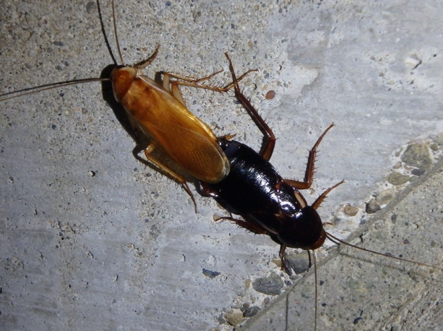
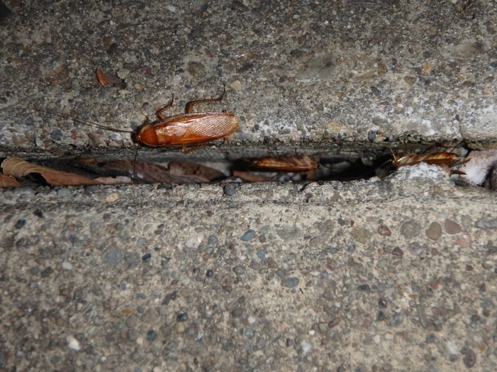
From these harborage sites, cockroaches venture out at night to feed on a wide variety of organic materials, such as food waste, manure, and both plant and animal matter in various stages of decomposition. In many cases, foraging cockroaches may enter structures that are not properly sealed, often triggering complaints and calls for pest control services.
What's the concern?
Though they don't pose the same threats to public health and indoor air quality as do German cockroaches (Blatella germanica), oriental and Turkestan cockroaches are often targeted by both indoor and outdoor insecticide applications, usually in the form of liquid or aerosol sprays. Perimeter protection services, where liquid formulations are regularly sprayed around building exteriors to provide repellency or residual toxicity for pests that may invade the structures from outside, are especially common for cockroaches. Such programs may be largely ineffective, however, since without exclusion measures, insects can still invade, only to die within buildings.
In addition, many insects have developed resistance to commonly used active ingredients, especially pyrethroid insecticides, due to widespread exposure in the environment and limited variety in pesticide products. Finally, such programs may be prohibited or discouraged because of regulations enacted to protect the environment and surrounding communities (see “Ask the Expert” on page 6 of the Summer 2019 issue of the Green Bulletin). For instance, public schools in California provide challenging settings for traditional perimeter protection since spray applications require special posting, notification, and reporting.
For all these reasons, professionals in California may consider alternatives to perimeter spray programs in order to provide effective control of these nuisance cockroaches for their customers.
Gel baits have proven very effective when used to control German cockroaches indoors, but can they be used for outdoor species? Furthermore, the use of baits within self-contained, tamper-proof bait stations is exempt from the notification and posting requirements associated with public schools.
Oriental and Turkestan cockroaches are most active during the warm summer and early autumn months, when conditions in many parts of California are extremely harsh, with very high daytime temperatures and very low relative humidity. Can baits hold up under those conditions and remain attractive, edible, and palatable to cockroaches?
Laboratory and Field Trials
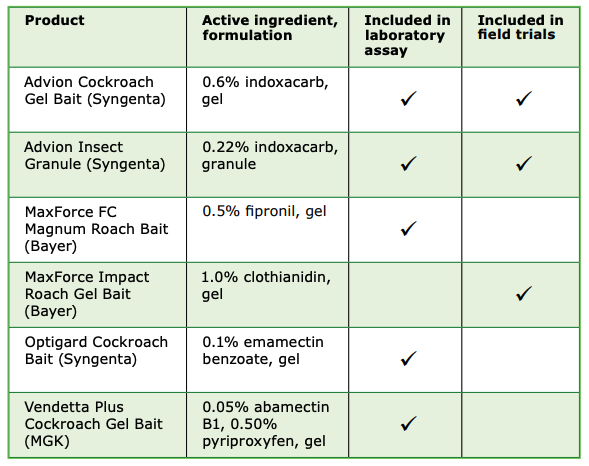
In order to measure the potential efficacy of exterior summertime applications, new groups of cockroaches were provided bait deposits dried on a lab bench for seven days. This drying period resulted in significant water loss from gel baits, rendering them quite hard and brittle. Nevertheless, exposure to dried baits also resulted in widespread mortality, with most groups of cockroaches exhibiting mortality at or near 100% after 14 days. In some cases, very little bait was consumed, suggesting that contact rather than ingestion contributed to mortality. These results suggest that many different professional cockroach baits are attractive to Blatta species, even when insects have access to alternative food and water sources, and that bait deposits can effectively kill cockroaches even when they are dried.
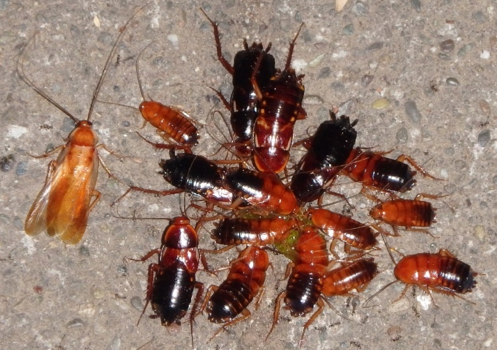
At these sites, three different bait products (Table 1) were applied within separate large (100-foot radius) treatment areas and compared to areas that were left untreated in terms of cockroach density, as measured by sticky traps placed out overnight once a month for one year. Bait was applied during periods of cockroach activity within locked rodent bait stations (Figure 4) or within subsurface utility ports (four bait placements of 1 g to 3 g per treatment area as needed monthly, according to observed cockroach density). Six applications were made at the Mendocino County site, while only two applications were made at the Riverside County site.
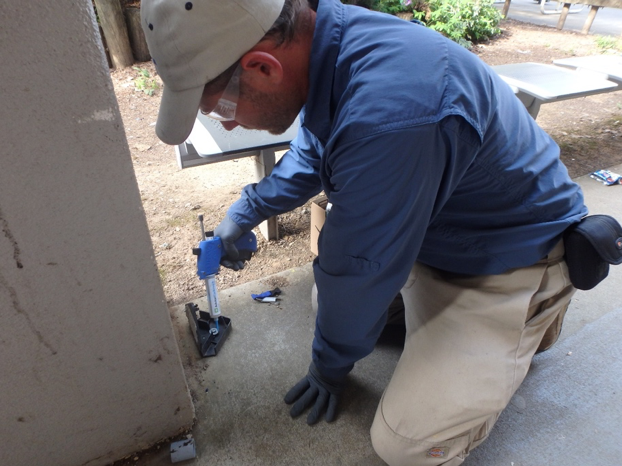
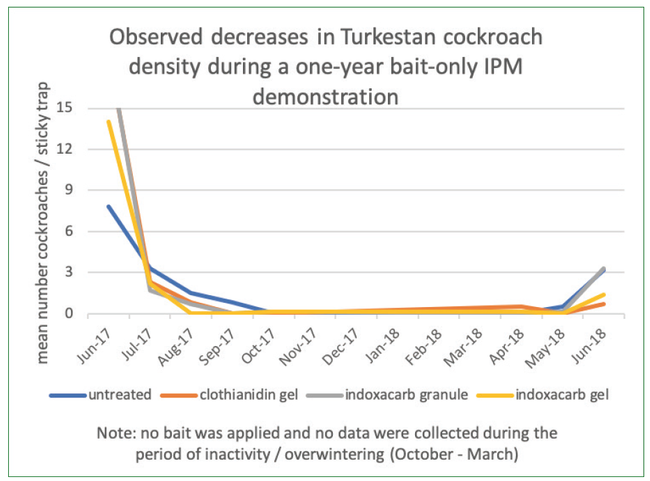
Control was achieved at both sites, but the population crash observed in Mendocino County was dramatic (Figure 5): 90% fewer cockroaches were trapped just one month after the baiting program began. Trap catches also fell by up to 50% in untreated plots. We believe these widespread decreases were driven by secondary and even tertiary mortality caused by cannibalism of bait-intoxicated cockroaches or scavenging of bait-killed cockroaches. This suggests that cockroaches in our field trial moved from one treatment area to the next, meaning that Turkestan cockroaches may venture more than 100 ft from harborages during foraging. Cannibalism was commonly observed in our overnight trapping programs, with trapped cockroaches dismembered and consumed by others (Figure 6).
At the Riverside County site, populations were smaller, foraging activity was lower, and population density within untreated plots remained high throughout the study. The one-year period ended at this site in October 2018, and preliminary data show that baits effectively reduced the population by 80% to 90% as compared to no treatment at all (Figure 7).
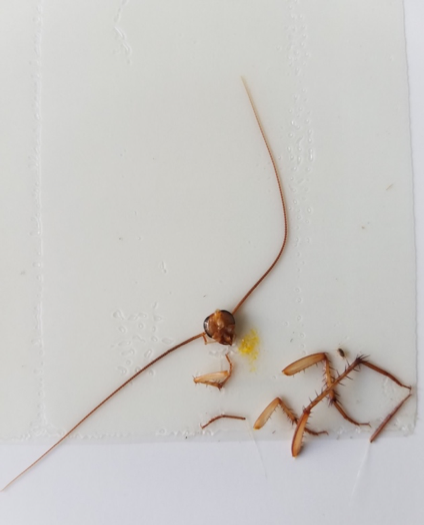

What did we find?
The results of this project suggest that bait-only programs can be very effective when used against oriental and Turkestan cockroaches in California, even when populations are large. The products tested were all very effective. We believe bait-only programs represent important alternatives to perimeter sprays and should be strongly considered when seeking to minimize exposure risk within IPM programs and when serving sensitive sites such as schools and child care centers, hospitals, municipal properties, and public outdoor spaces.
[Article originally published as "Outdoor baiting programs for cockroaches can provide excellent control" in the Summer 2019 issue of the Green Bulletin. For more on cockroaches and their management, see our Pest Notes: Cockroaches.]